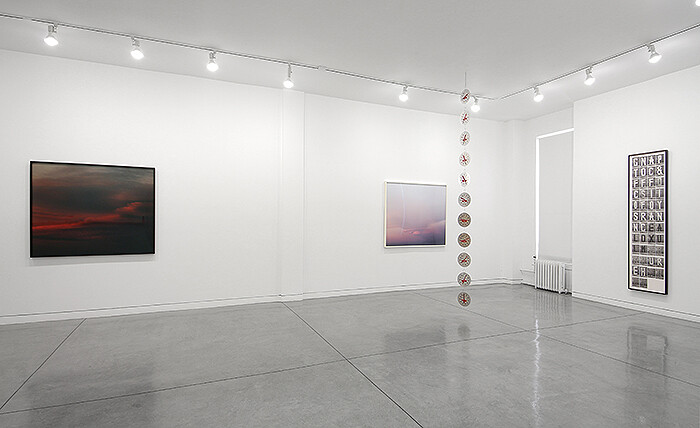“Transmissions” is the second of two back-to-back group shows at Altman Siegel. Gallery manager McIntyre Parker curated the first, which he titled after a line in a poem by Matthea Harvey: “O the sleeping bag contains the body but not the dreaming head.” In contrast to such titular loquaciousness, the show was an exercise in restraint. (Restraint also defines Pied-à-terre, Parker’s gemlike house gallery out towards the ocean, which often shows a single work by an artist in the basement garage.) Whole walls remained empty, and two of the three artists included (Aaron Flint Jamison and Anicka Yi) presented just one work apiece. Centered by Alice Channer’s draped floor-to-ceiling banner printed with a giant image of wet hair and Pantene shampoo and conditioner, the show felt unexpected, charged, and destabilizing. Destabilizing spatially, because of its utter precision, but also destabilizing—in the best way possible—any attempts at coming to grips with what this work values and what these young artists want.
By contrast, “Transmissions” is far tidier, and its art historical references are worn more readily on its sleeve. This second and current summer group show is both more conventional and yet more solid than its predecessor. It feels more familiar, too, because all of the artists are represented by the gallery, whereas in Parker’s show none were. More than anything, “Transmissions” attests to the strength of the gallery that Claudia Altman-Siegel has built up in just four years, and its vitality for the San Francisco art scene. The exhibition is essentially inventory by gallery artists put out for sale (more on this later), but all of the artists included here have compelling practices. And one of the most commendable aspects of the show is how seamlessly it integrates the local Bay Area artists Zarouhie Abdalian, Nate Boyce, and Liam Everett with those artists based in New York and Los Angeles, including Matt Keegan, Trevor Paglen, Sara VanDerBeek, and Shannon Ebner, respectively. Despite the too broad, too loosey-goosey title, there are some shared concerns here, particularly revolving around the dissolution of language into abstraction and form derived from modular and methodical processes. Abdalian and Boyce have been revelations of late, and though their work is wildly divergent in terms of means and ends, they both present hermetic, self-determining systems just shy of being full or whole. Abdalian’s The fall without the fruit (2013) is a series of fruit scales hanging from the ceiling, each one attached to the next and registering not the weight of fruit but the increasing weight of the scales each successively holds. In Boyce’s Untitled (Banana Cream), 2013, a sculpture—real, made in the world, then scanned and put through various filters—rotates on a computer screen mounted atop another steel sculpture. It’s the kind of minimal anarchy that David Smith would be impressed by.
To make his large-scale, full-color photographs of the Nevada sky, Paglen camped out at Creech Air Force Base in Indian Springs, equipped his digital camera with a sports photography lens designed to capture quick motion, and photographed drones on test flights at sunrise. Looking very carefully at the photographs, you’ll spot the drone in each one eventually, a tiny pin-prick in the sublime expanse, but there nonetheless, and in focus. Despite its miniscule size, the drone allows the dialectic between the aesthetic seduction of his images and what Paglen calls “the politics of production” to be maintained. It also proves that he was there, furtive and undetected unlike the drones. But there is a nagging feeling here: would these photographs succeed without the drone? Why must such potentially dangerous political work be so gorgeous, so welcoming of comparisons to Turner or Rothko? The citations are meant to recall “responses to some of the twentieth century’s greatest horrors suggesting the utter failure of representation.” Thus in Turner we grasp what Marx meant when he wrote that capital was the “annihilation of space with time.” But modernism also taught us, in T.J. Clark’s memorable turn of phrase, “the reason we all hate the beautiful so much.”
“Transmissions” was re-hung during the run of the show; hence the discrepancy between what is to be found on the gallery’s website and the works reviewed here. Pieces by Paglen and Keegan that sold were de-installed, one Paglen photograph was moved to the front gallery, and the back gallery was re-installed with newly-arrived work, including a white column sculpture by VanDerBeek evocative of a ritual object; a black canvas by Everett, the composition of which derives from chemical experiments with discharger, salt, and alcohol; and the aforementioned Boyce sculpture. Rehanging during a show’s run is unusual, a tactic more common in an art fair than in a gallery. That Altman Siegel insists this decision was curatorial rather than economical attests to the old necessity of masking the simple fact that a gallery is a salesroom, and is a bit disingenuous to curatorial work to boot. That said, the works as a whole provide for more food for thought than one would expect on a languid midsummer day.







